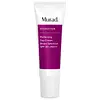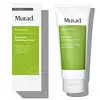What's inside
What's inside
 Key Ingredients
Key Ingredients

 Benefits
Benefits

 Concerns
Concerns

 Ingredients Side-by-side
Ingredients Side-by-side

Butyl Methoxydibenzoylmethane
UV AbsorberHomosalate 2%
Skin ConditioningEthylhexyl Methoxycinnamate 7.5%
UV AbsorberEthylhexyl Salicylate 5%
UV AbsorberBenzophenone-3 4%
UV AbsorberWater
Skin ConditioningButylene Glycol
HumectantPentylene Glycol
Skin ConditioningGlyceryl Stearate
EmollientPEG-100 Stearate
Diisopropyl Sebacate
EmollientIsodecyl Neopentanoate
EmollientLauryl Lactate
EmollientStearic Acid
CleansingSorbitan Stearate
EmulsifyingUrea
BufferingYeast Amino Acids
HumectantTrehalose
HumectantInositol
HumectantTaurine
BufferingBetaine
HumectantPhospholipids
Skin ConditioningRetinyl Palmitate
Skin ConditioningTocopheryl Acetate
AntioxidantAscorbyl Palmitate
AntioxidantCetearyl Alcohol
EmollientCeteareth-20
CleansingCitrus Medica Limonum Peel Extract
EmollientCalendula Officinalis Flower Extract
MaskingGlycolipids
Skin ConditioningSodium Hyaluronate
HumectantLecithin
EmollientTocopherol
AntioxidantHydrogen Peroxide
AntimicrobialDipotassium Glycyrrhizate
HumectantPunica Granatum Extract
AstringentMagnesium Ascorbyl Phosphate
AntioxidantHydrolyzed Soy Flour
Skin ConditioningAvena Sativa Kernel Protein
Skin ConditioningPalmitoyl Hydroxypropyltrimonium Amylopectin/Glycerin Crosspolymer
Skin ConditioningVitis Vinifera Seed Extract
AntimicrobialCamellia Sinensis Leaf Extract
AntimicrobialOenothera Biennis Oil
EmollientBorago Officinalis Seed Oil
EmollientSodium PCA
HumectantDimethicone
EmollientPropylene Glycol
HumectantCarbomer
Emulsion StabilisingSclerotium Gum
Emulsion StabilisingAminomethyl Propanol
BufferingChlorphenesin
AntimicrobialPhenoxyethanol
PreservativeMethylparaben
PreservativePropylparaben
PreservativeDisodium EDTA
Linalool
PerfumingLavandula Angustifolia Oil
MaskingButyl Methoxydibenzoylmethane, Homosalate 2%, Ethylhexyl Methoxycinnamate 7.5%, Ethylhexyl Salicylate 5%, Benzophenone-3 4%, Water, Butylene Glycol, Pentylene Glycol, Glyceryl Stearate, PEG-100 Stearate, Diisopropyl Sebacate, Isodecyl Neopentanoate, Lauryl Lactate, Stearic Acid, Sorbitan Stearate, Urea, Yeast Amino Acids, Trehalose, Inositol, Taurine, Betaine, Phospholipids, Retinyl Palmitate, Tocopheryl Acetate, Ascorbyl Palmitate, Cetearyl Alcohol, Ceteareth-20, Citrus Medica Limonum Peel Extract, Calendula Officinalis Flower Extract, Glycolipids, Sodium Hyaluronate, Lecithin, Tocopherol, Hydrogen Peroxide, Dipotassium Glycyrrhizate, Punica Granatum Extract, Magnesium Ascorbyl Phosphate, Hydrolyzed Soy Flour, Avena Sativa Kernel Protein, Palmitoyl Hydroxypropyltrimonium Amylopectin/Glycerin Crosspolymer, Vitis Vinifera Seed Extract, Camellia Sinensis Leaf Extract, Oenothera Biennis Oil, Borago Officinalis Seed Oil, Sodium PCA, Dimethicone, Propylene Glycol, Carbomer, Sclerotium Gum, Aminomethyl Propanol, Chlorphenesin, Phenoxyethanol, Methylparaben, Propylparaben, Disodium EDTA, Linalool, Lavandula Angustifolia Oil
Water
Skin ConditioningSodium Cocoyl Isethionate
CleansingGlyceryl Stearate Se
EmulsifyingGlycerin
HumectantStearic Acid
CleansingCetyl Alcohol
EmollientPrunus Armeniaca Kernel Oil
MaskingPalmitoyl Tripeptide-5
Skin ConditioningButyrospermum Parkii Butter Extract
Skin ConditioningCocamidopropyl Dimethylamine
EmulsifyingLactic Acid
BufferingHydrated Silica
AbrasivePhenylethyl Resorcinol
AntioxidantHydrolyzed Corn Starch
HumectantSodium Hydroxide
BufferingUrea
BufferingYeast Amino Acids
HumectantTrehalose
HumectantInositol
HumectantTaurine
BufferingBetaine
HumectantBorago Officinalis Seed Oil
EmollientOenothera Biennis Seed Extract
Skin ConditioningSerenoa Serrulata Fruit Extract
Skin ConditioningPanthenol
Skin ConditioningChondrus Crispus Extract
Skin ConditioningChamomilla Recutita Flower Extract
MaskingSodium Hyaluronate
HumectantImperata Cylindrica Root Extract
Skin ConditioningBenzophenone-4
UV AbsorberButylene Glycol
HumectantPEG-8
HumectantBenzalkonium Chloride
AntimicrobialCarbomer
Emulsion StabilisingXanthan Gum
EmulsifyingPhenoxyethanol
PreservativeCaprylyl Glycol
EmollientChlorphenesin
AntimicrobialParfum
MaskingWater, Sodium Cocoyl Isethionate, Glyceryl Stearate Se, Glycerin, Stearic Acid, Cetyl Alcohol, Prunus Armeniaca Kernel Oil, Palmitoyl Tripeptide-5, Butyrospermum Parkii Butter Extract, Cocamidopropyl Dimethylamine, Lactic Acid, Hydrated Silica, Phenylethyl Resorcinol, Hydrolyzed Corn Starch, Sodium Hydroxide, Urea, Yeast Amino Acids, Trehalose, Inositol, Taurine, Betaine, Borago Officinalis Seed Oil, Oenothera Biennis Seed Extract, Serenoa Serrulata Fruit Extract, Panthenol, Chondrus Crispus Extract, Chamomilla Recutita Flower Extract, Sodium Hyaluronate, Imperata Cylindrica Root Extract, Benzophenone-4, Butylene Glycol, PEG-8, Benzalkonium Chloride, Carbomer, Xanthan Gum, Phenoxyethanol, Caprylyl Glycol, Chlorphenesin, Parfum
Ingredients Explained
These ingredients are found in both products.
Ingredients higher up in an ingredient list are typically present in a larger amount.
Betaine is a common humectant (a substance that promotes retention of moisture). It's known to be gentle on the skin and can help balance hydration.
This ingredient is best for improving hydration and soothing irritated skin. Studies also show it helps even out skin tone.
Fun fact: Betaine is naturally created in the skin and body. The kind found within cosmetic products can be either plant-derived or synthetic.
Another name for betaine is trimethylglycine.
Learn more about BetaineBorago Officinalis Seed Oil is from the seeds of the starflower plant. This plant grows primarily in Europe.
This oil does not have a scent. It contains fatty acids such as linolenic acid. These fatty acids help keep skin hydrated.
Borago Officinalis Seed Oil is an antioxidant. Antioxidants help fight free-radicals. Free-radicals are molecules that may damage your skin cells.
Learn more about Borago Officinalis Seed OilButylene Glycol (or BG) is used within cosmetic products for a few different reasons:
Overall, Butylene Glycol is a safe and well-rounded ingredient that works well with other ingredients.
Though this ingredient works well with most skin types, some people with sensitive skin may experience a reaction such as allergic rashes, closed comedones, or itchiness.
Learn more about Butylene GlycolCarbomer is a polymer of acrylic acid. Its main role is to create a gel consistency.
A high amount of carbomer can cause pilling or balling up of products. Don't worry, most products contain 1% or less of carbomer.
Chlorphenesin is a synthetic preservative. It helps protect a product against bacteria in order to extend shelf life. In most cases, Chlorphenesin is paired with other preservatives such as phenoxyethanol and caprylyl glycol.
Chlorphenesin is a biocide. This means it is able to help fight the microorganisms on our skin. It is also able to fight odor-releasing bacteria.
Chlorphenesin is soluble in both water and glycerin.
Studies show Chlorphenesin is easily absorbed by our skin. You should speak with a skincare professional if you have concerns about using Chlorphenesin.
Learn more about ChlorphenesinInositol is a sugar alcohol naturally found in the human body. Our bodies use this ingredient in the process of growing new cells.
Studies show inositol to be a key component for keratinocyte growth.
Keratinocytes make up the majority of the outermost layer of skin. These cells protect our skin from UV exposure, infection, and help keep skin hydrated.
This ingredient is also considered a humectant. Humectants help hydrate the skin by drawing moisture to it.
Learn more about InositolPhenoxyethanol is a preservative that has germicide, antimicrobial, and aromatic properties. Studies show that phenoxyethanol can prevent microbial growth. By itself, it has a scent that is similar to that of a rose.
It's often used in formulations along with Caprylyl Glycol to preserve the shelf life of products.
Sodium Hyaluronate is hyaluronic acid's salt form. It is commonly derived from the sodium salt of hyaluronic acid.
Like hyaluronic acid, it is great at holding water and acts as a humectant. This makes it a great skin hydrating ingredient.
Sodium Hyaluronate is naturally occurring in our bodies and is mostly found in eye fluid and joints.
These are some other common types of Hyaluronic Acid:
Learn more about Sodium HyaluronateStearic Acid is a fatty acid. It is an emollient, emulsifier, and texture enhancer.
As an emollient, stearic acid helps soften skin. It aids the skin's protective barrier by preventing water loss. It also provides a gentle cleansing effect without stripping away natural oils.
Stearic acid may also be used to enhance the texture of products. It can add volume and stabilize ingredients such as water and oil. This can help water and oil ingredients from separating.
Sources of stearic acid include animal or vegetable fats/oils such as coconut or shea. It can be naturally found in butter, cocoa butter, shea butter, vegetable fats, and animal tallow.
This ingredient may not be Malassezia folliculitis, or fungal-acne safe.
Learn more about Stearic AcidWe don't have a description for Taurine yet.
Trehalose is a disaccharide made of two glucose molecules (glucose is sugar!). Trehalose is used to help moisturize skin. It also has antioxidant properties.
As a humectant, trehalose helps draw moisture from the air to your skin. This helps keep your skin hydrated.
Due to its antioxidant properties, trehalose may help with signs of aging. Antioxidants help fight free-radical molecules, unstable molecules that may damage your skin.
In medicine, trehalose and hyaluronic acid are used to help treat dry eyes.
Some animals, plants, and bacteria create trehalose as a source of energy to survive freeze or lack of water.
Learn more about TrehaloseUrea is also called carbamide and is the diamide of carbonic acid. In cosmetics, urea is used to hydrate the skin. It also provides exfoliation in higher concentrations.
As a humectant, urea helps draw moisture from the air and from deep within the skin. This helps hydrate your skin. Studies show urea is an effective moisturizer for dry skin conditions. 40% urea is typical in medications for treating eczema and other skin conditions.
Urea has the strongest exfoliation effect in concentrations higher than 10%. It is a keratolytic agent, meaning it breaks down the keratin protein in the top layer of skin. This helps remove dead skin cells and flaking skin.
In medicine, urea has been shown to help increase the potency of other ingredients, such as fungal treatments.
Humans and animals use urea to metabolize nitrogen-containing compounds. Urea is highly soluble in water. Once dissolved, it is neither acidic nor alkaline.
Learn more about UreaWater. It's the most common cosmetic ingredient of all. You'll usually see it at the top of ingredient lists, meaning that it makes up the largest part of the product.
So why is it so popular? Water most often acts as a solvent - this means that it helps dissolve other ingredients into the formulation.
You'll also recognize water as that liquid we all need to stay alive. If you see this, drink a glass of water. Stay hydrated!
Learn more about WaterWe don't have a description for Yeast Amino Acids yet.